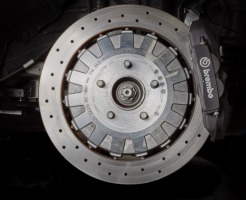A closer look at the Shelby GT350 suspension, chassis and braking systems

Shelby GT350’s rear springs are specially developed for maximum effectiveness at the track. To eke out every last bit of performance, engineers found having springs spin in different directions on each side of the car provided more rear-end stability. A counter-spun spring necessitated a new lower control arm design. “When you are engineering the most track-ready Mustang of all time, you can’t take any shortcuts,” says Eric Zinkosky, suspension and vehicle dynamics technical specialist. “This isn’t an off-the-shelf solution for us – we engineered every component to perform as well as possible, both on and off the track.”
Shelby GT350 is the first Ford vehicle to offer a MagneRide suspension, which allows for a wide range of adjustments in a matter of milliseconds. The system enables optimal performance for track use while not sacrificing comfort for the road. “The MagneRide computer system takes into account so many variables – from the obvious ones such as steering angle, pitch and yaw, to some measurements that are a bit more obscure,” says Brent Clark, vehicle dynamics supervisor. “Even ambient temperature measurements are fed into the computer to ensure optimal performance.”
Weight balance is essential for high-performance cornering and braking – both on and off the track. When weight can be removed from the nose, the benefit is drastic. Ford Performance engineers created a forged carbon fiber grille opening reinforcement for Shelby GT350 that is roughly 24 percent lighter than an equivalent stamped-steel component. The reduction of weight in the nose of the car allows for enhanced balance and more predictable handing.
To go fast, you first need to go slow. The brakes on Shelby GT350 are the most powerful brakes ever put on a production Mustang. After testing numerous brake setups, Ford Performance engineers discovered iron rotors provide improved performance and durability compared to carbon ceramic. Following several 24-hour endurance sessions, 394-milimeter front rotors and 380-milimeter rear rotors were chosen to provide stopping power for Shelby GT350. The two-piece rotors are assembled with an offset floating-pin system that allows for improved cooling and ventilation. Combined with six-piston front and four-piston rear calipers, these brakes experience virtually no fade in torture testing.
Ford Performance engineers approached the Shelby GT350 project with lofty goals for handling, supplying Michelin with desired longitudinal grip, lateral grip and tire wear parameters. Michelin tire engineers then formulated a unique compound of Pilot Super Sport tires for Shelby GT350 and Pilot Sport Cup 2 tires for Shelby GT350R that are designed to withstand extended track use – even in the hands of Ford’s best test drivers.
Comments
Be the first to post a comment
Post a Comment
You must be logged in to post a comment.
Recent Stories
- Mustang GTD the Fastest, Most Powerful Production Mustang in History
- The First-Ever Ford Mustang GTD
- 200 MPH Wind Tunnel Treadmill Helped Design the Most Aerodynamic, Track Capable Mustang
- 2024 Mustang Dark Horse Delivers 500 Horsepower, GT Delivers 480 Horsepower
- Ford Introduces Mustang Dark Horse and New Family of Track-Only Race Ponies
- Seventh Generation Mustang Revealed
Recent Forum Posts
- Clear corner headlights
- New Mustang Owner, some questions!
- LED headlights?
- $17,500 for a Ruby Red 2017 with 14,500 miles?
- New Mustang
- Unable to post Primary Photo
Participate In The Forums
Mustangs For Sale
- 2022 Mustang GT Premium: $44,000
- 2019 Mustang Bullitt: $41,500
- 1995 Mustang GT 5.0: $6,500 OBO
- 2008 Mustang Bullitt: $30,000
- And more...








